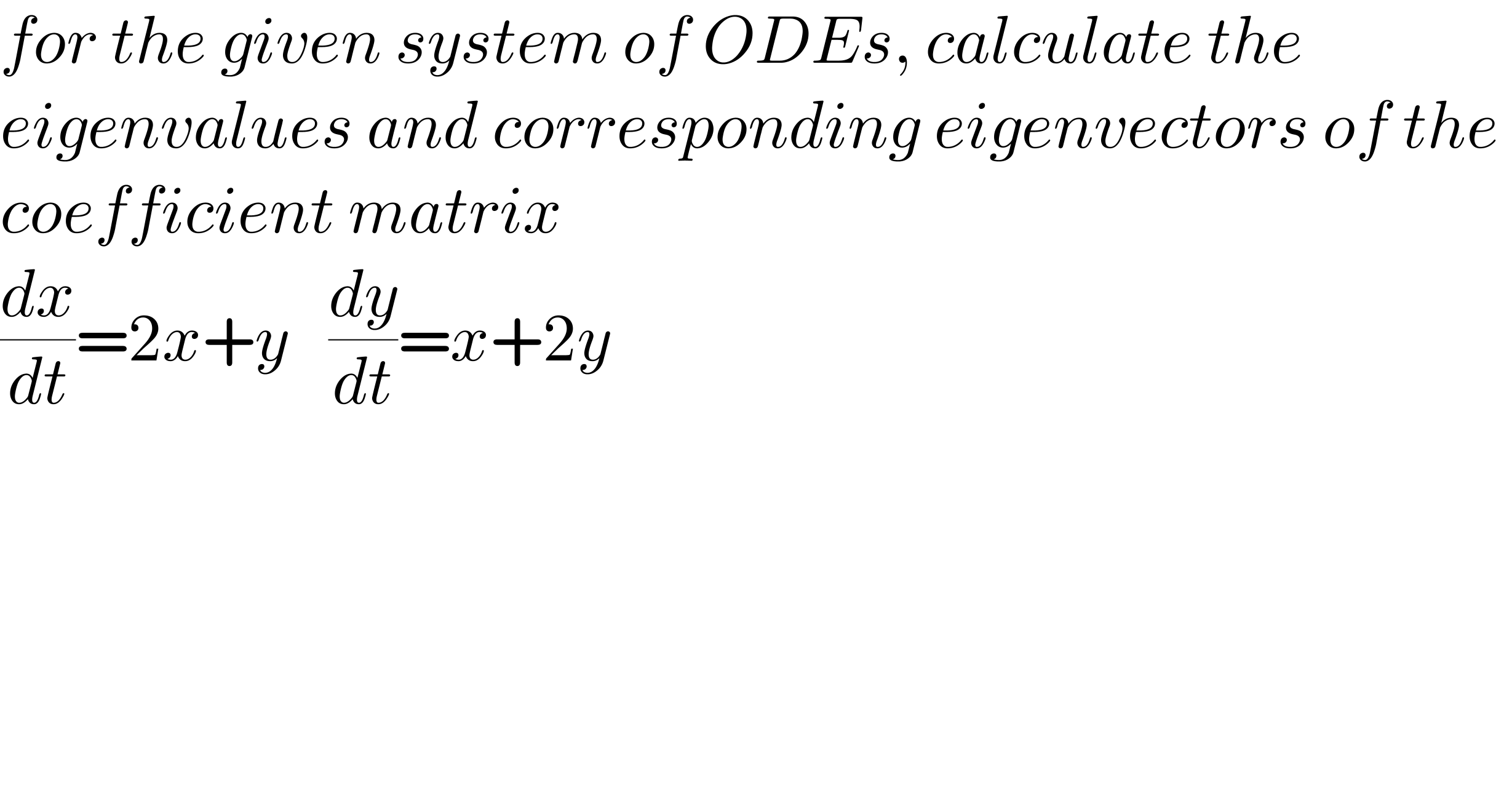
Question Number 207096 by Wuji last updated on 06/May/24

$${for}\:{the}\:{given}\:{system}\:{of}\:{ODEs},\:{calculate}\:{the} \\ $$$${eigenvalues}\:{and}\:{corresponding}\:{eigenvectors}\:{of}\:{the}\: \\ $$$${coefficient}\:{matrix} \\ $$$$\frac{{dx}}{{dt}}=\mathrm{2}{x}+{y}\:\:\:\frac{{dy}}{{dt}}={x}+\mathrm{2}{y} \\ $$
Commented by Wuji last updated on 07/May/24

$${need}\:{a}\:{helping}\:{hand},\:{please} \\ $$
Commented by aleks041103 last updated on 07/May/24

$${the}\:{idea}\:{is}\: \\ $$$${if}\:\:\:\boldsymbol{{q}}=\begin{pmatrix}{{x}}\\{{y}}\end{pmatrix}\:{and}\:{also}\:{then}\:\:\frac{{d}\boldsymbol{{q}}}{{dt}}=\begin{pmatrix}{{dx}/{dt}}\\{{dy}/{dt}}\end{pmatrix} \\ $$$${then}\:{you}\:{can}\:{write}\:{the}\:{linear}\:{ODE}\:{as} \\ $$$$\frac{{d}\boldsymbol{{q}}}{{dt}}=\hat {{M}}\:\boldsymbol{{q}}\: \\ $$$${where}\:\hat {{M}}\:{is}\:{the}\:{coefficient}\:{matrix} \\ $$$$ \\ $$$$\Rightarrow\:{in}\:{this}\:{case}\:{the}\:{coeff}\:{matrix}\:{is} \\ $$$$\begin{pmatrix}{\mathrm{2}}&{\mathrm{1}}\\{\mathrm{1}}&{\mathrm{2}}\end{pmatrix}... \\ $$$${try}\:{from}\:{here}\:{yourself} \\ $$
Commented by Wuji last updated on 07/May/24

$$\mathrm{yes},\:\mathrm{sir}.\:\:\mathrm{thank}\:\mathrm{you}\:\mathrm{so}\:\mathrm{much} \\ $$
Answered by mr W last updated on 07/May/24

$${alternative}\:{way}: \\ $$$$\left({i}\right)+\left({ii}\right): \\ $$$$\frac{{d}\left({x}+{y}\right)}{{dt}}=\mathrm{3}\left({x}+{y}\right) \\ $$$$\frac{{d}\left({x}+{y}\right)}{{x}+{y}}=\mathrm{3}{dt} \\ $$$$\Rightarrow\mathrm{ln}\:\left({x}+{y}\right)=\mathrm{3}{t}+{C} \\ $$$$\Rightarrow{x}+{y}=\mathrm{2}{C}_{\mathrm{1}} {e}^{\mathrm{3}{t}} \:\:\:...\left({I}\right) \\ $$$$\left({i}\right)−\left({ii}\right): \\ $$$$\frac{{d}\left({x}−{y}\right)}{{dt}}={x}−{y} \\ $$$$\frac{{d}\left({x}−{y}\right)}{{x}−{y}}={dt} \\ $$$$\Rightarrow\mathrm{ln}\:\left({x}−{y}\right)={t}+{C} \\ $$$$\Rightarrow{x}−{y}=\mathrm{2}{C}_{\mathrm{2}} {e}^{{t}} \:\:\:...\left({II}\right) \\ $$$$\Rightarrow{x}={C}_{\mathrm{1}} {e}^{\mathrm{3}{t}} +{C}_{\mathrm{2}} {e}^{{t}} \\ $$$$\Rightarrow{y}={C}_{\mathrm{1}} {e}^{\mathrm{3}{t}} −{C}_{\mathrm{2}} {e}^{{t}} \\ $$
Commented by Wuji last updated on 07/May/24

$$\mathrm{God}\:\mathrm{bless}\:\mathrm{you},\:\mathrm{sir} \\ $$
